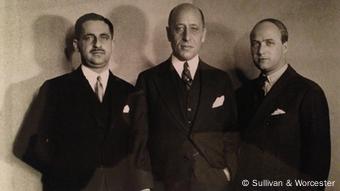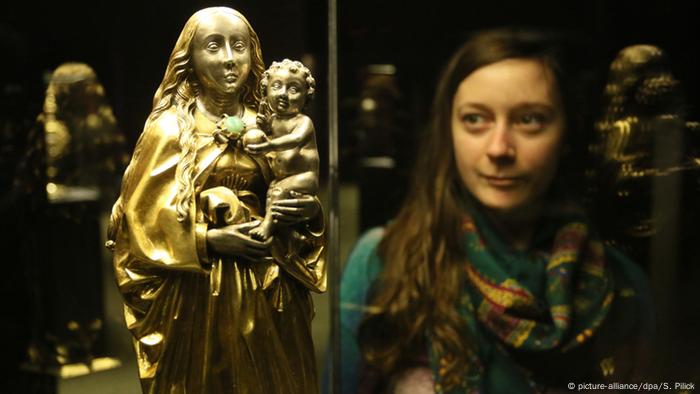Art
Long-standing Nazi art dispute heard by US Supreme Court – DW (English)

Should US courts decide on the fate of the Guelph Treasure — masterpieces of medieval art acquired by the Nazis? The case could establish a precedent for many other artworks.
One of the most spectacular art litigation cases in recent history has landed at the US Supreme Court. Descendants of Jewish art dealers are suing the German government over a collection of medieval ecclesiastical artifacts known as the Guelph Treasure (“Welfenschatz”), which they claim were illegally appropriated by the Nazis.
The highest court in the United States is to determine whether the long-standing case can be pursued in the country.
A German case in the United States
Hermann Parzinger, president of the Prussian Cultural Heritage Foundation — which manages the Berlin Museum of Decorative Arts, where the collection is housed — argues that the suit should be dismissed: “Our view is that Germany is the proper jurisdiction for a case which involves a sale of a collection of medieval German art by German art dealers to a German state,” Parzinger said in a statement.
In a brief filed before the session, the government underlined that it takes such claims seriously: “The German government has provided roughly $100 billion (in today’s dollars) to compensate Holocaust survivors and other victims of the Nazi era,” the brief states. The German state however argues that since the sale took place between Germans on German soil, only the German courts could rule in this case.
To decide otherwise, the brief added, “will have grave foreign policy consequences, inviting a host of lawsuits against foreign sovereigns for their domestic, sovereign acts — and may prompt other nations to reciprocate, forcing the United States to defend similar actions.”
The US government supports Germany in the case.
A gift for Hitler
The Guelph Treasure comprises 44 masterpieces of medieval church art that derive from the House of Guelph (or Welf), one of the oldest princely houses in Europe that amassed extensive art collections.
Having purchased the Guelph Treasure from the Welfen family in 1929, a consortium of Jewish art dealers sold single pieces the following year, before offloading the remaining 42 gilded and bejeweled works to the Prussian state for its own collection in 1935.
Hermann Göring, the then Prime Minister of Prussia and head of the German air force, presented the treasure to Hitler as a personal gift. But the heirs of the Jewish art dealers say this present was extorted.
It is alleged, for instance, that one of the art dealers, Samy Rosenberg, received murder threats. His heirs argue that if he had not sold the treasure for the low market value set by the Nazis, he and his family would never have been taken out of Germany.
This appraisal of events was accepted by US judge Colleen Kollar-Kotelly back in 2017, who stated: “The taking of the Welfenschatz … bears a sufficient connection to genocide such that the alleged coerced sale may amount to a taking in violation of international law.” Indeed, if the case comes under international law, the principle under which a sovereign state cannot be sued before the courts of another state becomes irrelevant.
A ‘fair deal’ in 1935?
The key question in the upcoming lawsuit is whether every possible Nazi stolen art case must be investigated in detail or whether is it sufficient to presume that after Hitler’s takeover of power in 1933, Jewish art dealers were gradually disenfranchised and thus were no longer on a level playing field in the art market.
The Prussian Cultural Heritage Foundation argues with the former, claiming that an appropriate price had been paid in 1935 as a global economic crisis had depressed the art market. Parzinger said records “clearly show that there were long and tough negotiations on the price and that the two sides met exactly in the middle of their initial starting prices.”
However, the art dealers’ heirs argue that in 1935 it was not possible to have a “fair deal” for Jewish art dealers. They say the purchase price, 4.25 million reichsmark, was about one-third of what the collection was worth. Under international law principles, sales of property by Jews in Nazi Germany are also presumed to have been done under pressure and therefore invalid, said the heirs’ attorney, Nicholas O’Donnell.
No law for stolen art cases in Germany
As early as 2008, attorneys representing the Jewish art dealers requested that the Prussian Cultural Heritage Foundation return the Guelph Treasure to the rightful owners.
But in 2015, the so-called Limbach Commission of independent experts recommended that the treasure be left in Berlin, arguing that the price paid in 1935 corresponded to the then market value. The attorneys representing the heirs of the Jewish art dealers had then said that they had no choice but to file lawsuits before a Washington DC court, since there is no legal basis for courts to consider restitution cases in Germany. The Limbach Commission can only make a recommendation that is not legally binding.
Over the years, the case made its way to the US Supreme Court, which will now hear arguments to determine whether the heirs of the collection should be allowed to continue their lawsuit in US courts. A ruling is expected by June 2021.
If US courts are found to have jurisdiction in the Guelph Treasure case, it could become the precedent for further such actions. As such, the burden of proof would no longer lie with the heirs of possibly disenfranchised art dealers or private owners. German museums would instead have to prove that they are legal owners of art works that came into their possession during the Nazi era.
Art
Calvin Lucyshyn: Vancouver Island Art Dealer Faces Fraud Charges After Police Seize Millions in Artwork

In a case that has sent shockwaves through the Vancouver Island art community, a local art dealer has been charged with one count of fraud over $5,000. Calvin Lucyshyn, the former operator of the now-closed Winchester Galleries in Oak Bay, faces the charge after police seized hundreds of artworks, valued in the tens of millions of dollars, from various storage sites in the Greater Victoria area.
Alleged Fraud Scheme
Police allege that Lucyshyn had been taking valuable art from members of the public under the guise of appraising or consigning the pieces for sale, only to cut off all communication with the owners. This investigation began in April 2022, when police received a complaint from an individual who had provided four paintings to Lucyshyn, including three works by renowned British Columbia artist Emily Carr, and had not received any updates on their sale.
Further investigation by the Saanich Police Department revealed that this was not an isolated incident. Detectives found other alleged victims who had similar experiences with Winchester Galleries, leading police to execute search warrants at three separate storage locations across Greater Victoria.
Massive Seizure of Artworks
In what has become one of the largest art fraud investigations in recent Canadian history, authorities seized approximately 1,100 pieces of art, including more than 600 pieces from a storage site in Saanich, over 300 in Langford, and more than 100 in Oak Bay. Some of the more valuable pieces, according to police, were estimated to be worth $85,000 each.
Lucyshyn was arrested on April 21, 2022, but was later released from custody. In May 2024, a fraud charge was formally laid against him.
Artwork Returned, but Some Remain Unclaimed
In a statement released on Monday, the Saanich Police Department confirmed that 1,050 of the seized artworks have been returned to their rightful owners. However, several pieces remain unclaimed, and police continue their efforts to track down the owners of these works.
Court Proceedings Ongoing
The criminal charge against Lucyshyn has not yet been tested in court, and he has publicly stated his intention to defend himself against any pending allegations. His next court appearance is scheduled for September 10, 2024.
Impact on the Local Art Community
The news of Lucyshyn’s alleged fraud has deeply affected Vancouver Island’s art community, particularly collectors, galleries, and artists who may have been impacted by the gallery’s operations. With high-value pieces from artists like Emily Carr involved, the case underscores the vulnerabilities that can exist in art transactions.
For many art collectors, the investigation has raised concerns about the potential for fraud in the art world, particularly when it comes to dealing with private galleries and dealers. The seizure of such a vast collection of artworks has also led to questions about the management and oversight of valuable art pieces, as well as the importance of transparency and trust in the industry.
As the case continues to unfold in court, it will likely serve as a cautionary tale for collectors and galleries alike, highlighting the need for due diligence in the sale and appraisal of high-value artworks.
While much of the seized artwork has been returned, the full scale of the alleged fraud is still being unraveled. Lucyshyn’s upcoming court appearances will be closely watched, not only by the legal community but also by the wider art world, as it navigates the fallout from one of Canada’s most significant art fraud cases in recent memory.
Art collectors and individuals who believe they may have been affected by this case are encouraged to contact the Saanich Police Department to inquire about any unclaimed pieces. Additionally, the case serves as a reminder for anyone involved in high-value art transactions to work with reputable dealers and to keep thorough documentation of all transactions.
As with any investment, whether in art or other ventures, it is crucial to be cautious and informed. Art fraud can devastate personal collections and finances, but by taking steps to verify authenticity, provenance, and the reputation of dealers, collectors can help safeguard their valuable pieces.
Art
Ukrainian sells art in Essex while stuck in a warzone – BBC.com
[unable to retrieve full-text content]
Ukrainian sells art in Essex while stuck in a warzone BBC.com

Source link
Art
Somerset House Fire: Courtauld Gallery Reopens, Rest of Landmark Closed
The Courtauld Gallery at Somerset House has reopened its doors to the public after a fire swept through the historic building in central London. While the gallery has resumed operations, the rest of the iconic site remains closed “until further notice.”
On Saturday, approximately 125 firefighters were called to the scene to battle the blaze, which sent smoke billowing across the city. Fortunately, the fire occurred in a part of the building not housing valuable artworks, and no injuries were reported. Authorities are still investigating the cause of the fire.
Despite the disruption, art lovers queued outside the gallery before it reopened at 10:00 BST on Sunday. One visitor expressed his relief, saying, “I was sad to see the fire, but I’m relieved the art is safe.”
The Clark family, visiting London from Washington state, USA, had a unique perspective on the incident. While sightseeing on the London Eye, they watched as firefighters tackled the flames. Paul Clark, accompanied by his wife Jiorgia and their four children, shared their concern for the safety of the artwork inside Somerset House. “It was sad to see,” Mr. Clark told the BBC. As a fan of Vincent Van Gogh, he was particularly relieved to learn that the painter’s famous Self-Portrait with Bandaged Ear had not been affected by the fire.
Blaze in the West Wing
The fire broke out around midday on Saturday in the west wing of Somerset House, a section of the building primarily used for offices and storage. Jonathan Reekie, director of Somerset House Trust, assured the public that “no valuable artefacts or artworks” were located in that part of the building. By Sunday, fire engines were still stationed outside as investigations into the fire’s origin continued.
About Somerset House
Located on the Strand in central London, Somerset House is a prominent arts venue with a rich history dating back to the Georgian era. Built on the site of a former Tudor palace, the complex is known for its iconic courtyard and is home to the Courtauld Gallery. The gallery houses a prestigious collection from the Samuel Courtauld Trust, showcasing masterpieces from the Middle Ages to the 20th century. Among the notable works are pieces by impressionist legends such as Edouard Manet, Claude Monet, Paul Cézanne, and Vincent Van Gogh.
Somerset House regularly hosts cultural exhibitions and public events, including its popular winter ice skating sessions in the courtyard. However, for now, the venue remains partially closed as authorities ensure the safety of the site following the fire.
Art lovers and the Somerset House community can take solace in knowing that the invaluable collection remains unharmed, and the Courtauld Gallery continues to welcome visitors, offering a reprieve amid the disruption.
-

 News2 hours ago
News2 hours agoSleep Country shareholders approve sale to Fairfax Financial
-

 News2 hours ago
News2 hours agoAlberta Premier Smith aims to help fund private school construction
-

 News2 hours ago
News2 hours agoNurse-patient ratios at B.C. hospitals set to expand in fall, says health minister
-

 News2 hours ago
News2 hours agoSecond-half goals lift defending MLS champion Columbus past Toronto FC
-

 News2 hours ago
News2 hours agoFirst-degree murder charge in death of five-year-old Quebec boy: Crown
-

 News2 hours ago
News2 hours agoVancouver Canucks will miss Demko, Joshua, others to start training camp
-

 News2 hours ago
News2 hours agoAlert lifted after arrest of one of two armed robbery suspects in Alberta
-

 News2 hours ago
News2 hours agoGirl faces new charge after student set on fire in Saskatoon high school






















